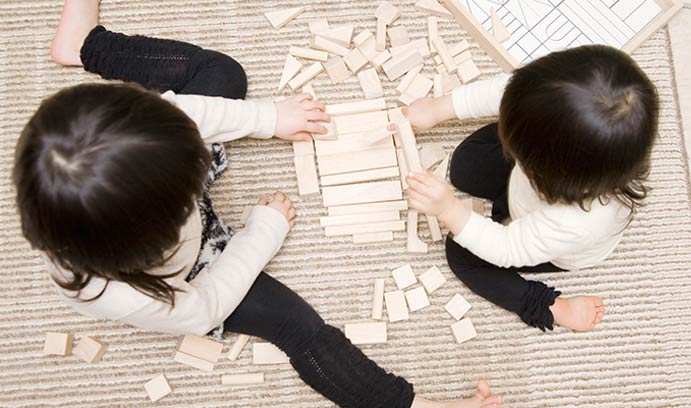Building Knowledge

Researchers examine children's geometric learning with real and virtual building blocks.
"Geometry and spatial sense are a primary domain of early mathematical development," says Robin Hojnoski, associate professor of school psychology. "Three-dimensional shapes are important, and how kids use shapes ... is really related to spatial sense: being able to have a design in mind and then mentally rotate to form that design and then make it happen. Those things are important to overall spatial sense and spatial development, which are key skills related to STEM [science, technology, engineering and math] fields."
Hojnoski and doctoral student Brittany Kuder wanted to learn what child abilities relate to geometric abilities. In summer 2015, they observed more than 100 children in area preschool and child care classrooms as the children built with blocks. They administered tasks related to spatial ability, self-regulation, receptive vocabulary and picture memory, as well as assessments such as Panamath, which measures number sense.
In early 2016, Hojnoski and Kuder examined the behavioral and mathematical skills of prior participants following their respective transitions to pre-kindergarten and kindergarten. Focusing on the children's classroom participation, early math skills and social competence, Kuder and several other graduate students in school psychology collected parent and teacher behavior-rating scales, conducted classroom observations, and administered an early math skills assessment. They plan to use the data gathered to connect skills measured over the previous summer with outcomes measured approximately six months later.
The data Kuder collected also supports the development of BuildSpace, an app that aims to replicate a child's three-dimensional block-building experience on a tablet or mobile device. The app, which began as a 2015 Mountaintop project in collaboration with Michael Spear, assistant professor of computer science and engineering and Luke Zhang '15, a computer science and engineering student, allows children to select and move shapes to build a virtual structure. Undergraduate computer science and engineering students Mike Green '16 and Chris Szafranski '18 have been working through this academic year to further refine BuildSpace so it is ready for testing this summer.
Hojnoski, Kuder and Spear will return to Mountaintop this summer with four undergraduate students and a new set of goals.
"One objective we have for this summer is to compare the learning that takes place when kids build on the app in free play versus building with the physical geometric solids in real life," says Kuder.
The team plans an intervention study in which they'll assign children to two conditions: building with physical blocks or building on the app. The team will then evaluate the different conditions based on the spatial learning gains that take place.
"We're trying to pick skills we think the physical blocks and digital blocks will differentially target. We're thinking that children who work with the physical blocks will have greater advances in their shape description and shape identification, whereas because [the app] encourages different perspective-taking, children might have differential learning in terms of spatial visualization and mental transformation," says Kuder.
This summer, Kuder and Mountaintop team members will use a standard battery of assessments to gather data from more children. Computer science and engineering students will tweak the app to improve user experience based on feedback gathered from children who use it.
The team will also explore the app's "back-end" data, which can provide insight into how children use the app and how that relates to measures of child development and demographic data.
"With what technology is now capable of, we can examine intricacies and patterns of children's behavior that would otherwise be difficult if not impossible to measure," says Kuder. "This could have vast implications for advancing our knowledge base on child development."
Posted on:

